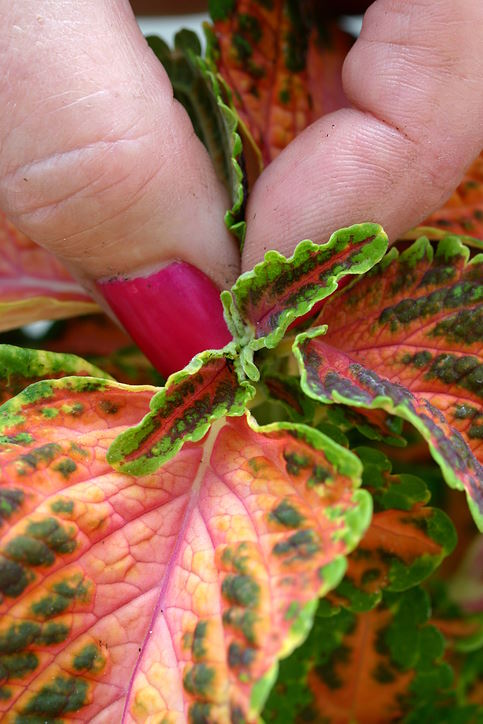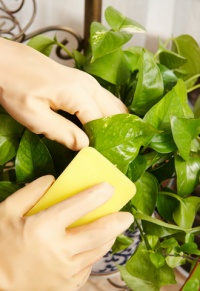Pinching, Pruning and Cleaning:
A Grooming Guide for Your House Plants
House plants occasionally need grooming to keep them healthy and attractive. Regular maintenance not only makes your plants look their best, it helps to prevent pests and diseases, too.
Disclosure: Guide-to-Houseplants.com participates in affiliate programs. If you make a purchase after following the links on this page, I may receive a commission at no additional cost to you.
Pinching House Plants
Using your thumb and forefinger to remove a tip of a stem is known as pinching a plant.
 Pinching growing tip on coleus plant. Image ©istockphoto
Pinching growing tip on coleus plant. Image ©istockphotoPinching off growing tips will keep a fast-growing vine compact or help to maintain a plant's bushy shape. When a young stem tip is pinched off, the plant will branch out and become bushier and fuller.
Always pinch above a node -- the growing point where a leaf is attached. Cuts made here usually force branching below the cut.
Pinching works well for soft-stemmed plants such as coleus (shown at right) -- as well as heartleaf philodendron, English ivy and pothos -- that can grow long and leggy.
If a vine can't be easily pinched off with your fingernail, use sharp pruners to avoid tearing a stem.
Pruning House Plants
Never pull on stems or leaves to remove them. Use houseplant pruners or scissors to make clean cuts and to avoid tearing -- which can attract a fungal disease.
Cut off any dead stems or branches, which can attract fungus. Remove brown or yellow leaves as well so they don't decay and attract disease and insects.
Pruning house plants is best when the plant is actively growing, usually in the spring and summer months, although light trimming can be done any time of year.
Cut above a leaf node (the place where a leaf attaches to the stem) at a 45° angle. Cuts made here will help the plant to branch out, creating a fuller, more compact plant.
Wondering whether or not to prune? Don't guess about your plant...look it up in the house plants encyclopedia.
Deadheading Flowers
Using clean, sharp pruners or scissors, remove any dead flower heads as soon as you notice them. Dying flowers on a plant not only look unsightly, but they are likely to rot, making them a target for attack by gray mold.
Deadheading removes the developing seeds. Unless the seeds are going to be collected and used, producing seeds wastes the plant's energy. You'll help extend the blooming time of your plant by removing the flowers as they fade. This allows the plant to devote its energy to growing more buds.
Obviously, you shouldn't cut off the flowers of fruit trees or they won't bear fruit. Some house plants, such as hoyas and orchids, will flower again on the same flower stem, so it's a good idea to know your plant and find out if you should cut off the flowers and when.
Cleaning House Plants
Keeping your plant's leaves dust-free helps it get the light exposure it needs to grow. Cleaning the leaves also helps rid them of insects.

Smooth leaves can easily be wiped clean with a damp cloth or a sponge dipped in water. It's a good idea to clean the cloth or sponge before using it on another plant so it's not giving insects a ride from one plant to another.
Plants with hairy leaves, such as African violets, should be gently brushed with a soft brush (I use a small paintbrush) to remove dust and dirt. Why? If water is used to clean hairy-leafed plants, water spots will develop on their leaves and they won't come off.
Fine-foliage plants, such as ferns, can be cleaned with a gentle spray of water. When the weather is warm, sometimes it's easiest to take the plant outdoors and give it a fine spray of water from all sides with a water bottle. Cover the soil so that it doesn't become soggy. Gently shake off excess water and allow the plant to dry in a place protected from direct sun before returning it indoors.


